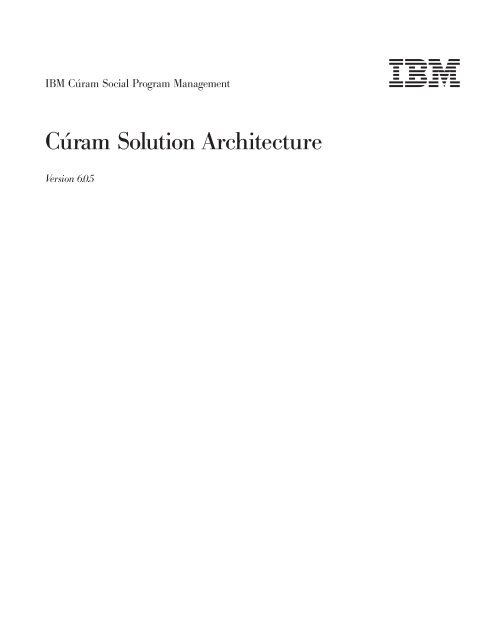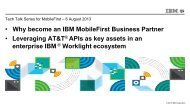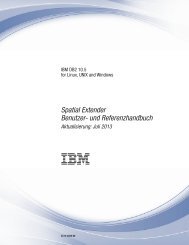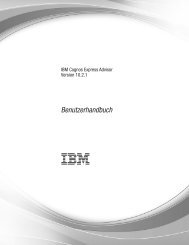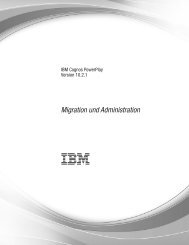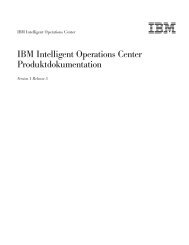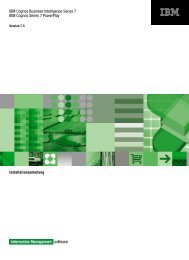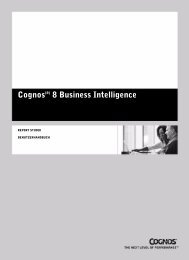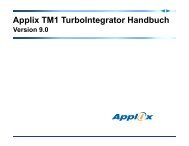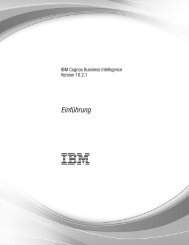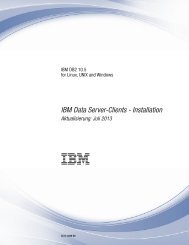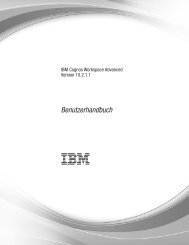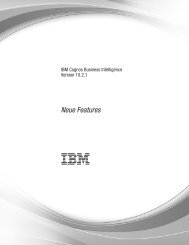IBM Cúram Social Program Management: Cúram Solution Architecture
IBM Cúram Social Program Management: Cúram Solution Architecture
IBM Cúram Social Program Management: Cúram Solution Architecture
You also want an ePaper? Increase the reach of your titles
YUMPU automatically turns print PDFs into web optimized ePapers that Google loves.
<strong>IBM</strong> <strong>Cúram</strong> <strong>Social</strong> <strong>Program</strong> <strong>Management</strong><br />
<br />
<strong>Cúram</strong> <strong>Solution</strong> <strong>Architecture</strong><br />
Version 6.0.5
<strong>IBM</strong> <strong>Cúram</strong> <strong>Social</strong> <strong>Program</strong> <strong>Management</strong><br />
<br />
<strong>Cúram</strong> <strong>Solution</strong> <strong>Architecture</strong><br />
Version 6.0.5
Hinweis<br />
Vor Verwendung dieser Informationen und des darin beschriebenen Produkts sollten die Informationen in „Bemerkungen”<br />
auf Seite 23 gelesen werden.<br />
Überarbeitung: Mai 2013<br />
Diese Ausgabe bezieht sich auf <strong>IBM</strong> <strong>Cúram</strong> <strong>Social</strong> <strong>Program</strong> <strong>Management</strong> v6.0.5 und alle nachfolgenden Releases,<br />
sofern nicht anderweitig in neuen Auusgaben angegeben.<br />
Licensed Materials - Property of <strong>IBM</strong>.<br />
© Copyright <strong>IBM</strong> Corporation 2012, 2013.<br />
© <strong>Cúram</strong> Software Limited. 2011. All rights reserved.
Inhaltsverzeichnis<br />
Abbildungsverzeichnis . . . . . . . . v<br />
Tabellen . . . . . . . . . . . . . . vii<br />
Kapitel 1. Einführung . . . . . . . . . 1<br />
1.1 Einführung. . . . . . . . . . . . . . 1<br />
Kapitel 2. Business <strong>Architecture</strong> . . . . 3<br />
2.1 Business <strong>Architecture</strong> . . . . . . . . . . 3<br />
Kapitel 3. The <strong>Cúram</strong> Application Development<br />
Environment . . . . . . . . . 5<br />
3.1 Einführung. . . . . . . . . . . . . . 5<br />
3.2 Development Environment Objectives. . . . . 5<br />
3.3 Using the Environment . . . . . . . . . 6<br />
3.4 Modeling with <strong>Cúram</strong> . . . . . . . . . . 6<br />
3.5 Implementation . . . . . . . . . . . . 6<br />
3.6 Building . . . . . . . . . . . . . . 6<br />
3.7 Deployment . . . . . . . . . . . . . 7<br />
Kapitel 4. Runtime <strong>Architecture</strong>. . . . . 9<br />
4.1 Einführung. . . . . . . . . . . . . . 9<br />
4.2 The Relationship to Java EE <strong>Architecture</strong> . . . . 9<br />
4.3 Summary of Java Technologies Used . . . . . 10<br />
4.4 Java EE Design Patterns . . . . . . . . . 10<br />
4.5 Presentation Tier Runtime <strong>Architecture</strong> . . . . 10<br />
4.6 The Struts Framework . . . . . . . . . 12<br />
4.7 Business Logic Tier Runtime <strong>Architecture</strong> . . . 12<br />
4.8 Remote Interface Layer . . . . . . . . . 12<br />
4.9 Business Object Layer . . . . . . . . . . 13<br />
4.10 Facade Layer . . . . . . . . . . . . 13<br />
4.11 Service Layer . . . . . . . . . . . . 13<br />
4.12 Factory Methods . . . . . . . . . . . 13<br />
4.13 Connectors . . . . . . . . . . . . . 14<br />
Kapitel 5. Development <strong>Architecture</strong> . . 15<br />
5.1 Einführung . . . . . . . . . . . . . 15<br />
5.2 Server Development Environment. . . . . . 15<br />
5.3 Application Model . . . . . . . . . . . 15<br />
5.4 Application ModelDomains . . . . . . . . 15<br />
5.5 Application ModelEntities . . . . . . . . 16<br />
5.6 Application ModelProcesses. . . . . . . . 16<br />
5.7 Server Code Generation . . . . . . . . . 16<br />
5.8 Client Development Environment . . . . . . 17<br />
5.9 Übersicht . . . . . . . . . . . . . . 17<br />
5.10 User Interface Development . . . . . . . 17<br />
5.11 Client Code Generation . . . . . . . . . 18<br />
Kapitel 6. Business Infrastructure . . . 19<br />
6.1 Einführung . . . . . . . . . . . . . 19<br />
6.2 Rules Development Environment . . . . . . 19<br />
6.3 Eligibility and Entitlement Processing . . . . 19<br />
6.4 XML and Printing . . . . . . . . . . . 19<br />
6.5 Workflow . . . . . . . . . . . . . . 20<br />
Bemerkungen. . . . . . . . . . . . 23<br />
Informationen zu <strong>Program</strong>mierschnittstellen . . . 25<br />
Marken . . . . . . . . . . . . . . . . 25<br />
© Copyright <strong>IBM</strong> Corp. 2012, 2013 iii
iv<br />
<strong>IBM</strong> <strong>Cúram</strong> <strong>Social</strong> <strong>Program</strong> <strong>Management</strong>: <strong>Cúram</strong> <strong>Solution</strong> <strong>Architecture</strong>
Abbildungsverzeichnis<br />
1. <strong>Cúram</strong> Business Model . . . . . . . . . 3<br />
2. Invocation Options . . . . . . . . . . 7<br />
3. Client Runtime <strong>Architecture</strong> . . . . . . . 11<br />
4. Client Runtime <strong>Architecture</strong> (Level 2) . . . . 11<br />
5. Server Runtime <strong>Architecture</strong> . . . . . . . 12<br />
6. Business Object Layer . . . . . . . . . 13<br />
7. Server Code Generation . . . . . . . . 16<br />
8. Sample <strong>Cúram</strong> User Interface . . . . . . 18<br />
9. Client Code Generation . . . . . . . . 18<br />
10. XML and PDF Printing. . . . . . . . . 20<br />
© Copyright <strong>IBM</strong> Corp. 2012, 2013 v
vi<br />
<strong>IBM</strong> <strong>Cúram</strong> <strong>Social</strong> <strong>Program</strong> <strong>Management</strong>: <strong>Cúram</strong> <strong>Solution</strong> <strong>Architecture</strong>
Tabellen<br />
© Copyright <strong>IBM</strong> Corp. 2012, 2013 vii
viii<br />
<strong>IBM</strong> <strong>Cúram</strong> <strong>Social</strong> <strong>Program</strong> <strong>Management</strong>: <strong>Cúram</strong> <strong>Solution</strong> <strong>Architecture</strong>
Kapitel 1. Einführung<br />
1.1 Einführung<br />
This document provides an overview of the solution architecture of <strong>IBM</strong> ® <strong>Cúram</strong> <strong>Social</strong> <strong>Program</strong> <strong>Management</strong><br />
from a business, development and deployment perspective. <strong>Cúram</strong> is a comprehensive commercial-off-the-shelf<br />
(COTS) solution for <strong>Social</strong> Enterprises. <strong>IBM</strong> <strong>Cúram</strong> <strong>Social</strong> <strong>Program</strong> <strong>Management</strong> also<br />
includes a environment for organizations wishing to develop their own <strong>Social</strong> Enterprise <strong>Management</strong><br />
applications, or to augment those provided by <strong>IBM</strong>. An architectural description of <strong>IBM</strong> <strong>Cúram</strong> <strong>Social</strong><br />
<strong>Program</strong> <strong>Management</strong> must thus describe the components of existing „out-of-the-box” business applications,<br />
and the technical architecture of the framework which underpins those applications and is reusable<br />
by developers building additional ones.<br />
© Copyright <strong>IBM</strong> Corp. 2012, 2013 1
2 <strong>IBM</strong> <strong>Cúram</strong> <strong>Social</strong> <strong>Program</strong> <strong>Management</strong>: <strong>Cúram</strong> <strong>Solution</strong> <strong>Architecture</strong>
Kapitel 2. Business <strong>Architecture</strong><br />
2.1 Business <strong>Architecture</strong><br />
<strong>IBM</strong> <strong>Cúram</strong> <strong>Social</strong> <strong>Program</strong> <strong>Management</strong> is designed specifically for human services, health, labor, social<br />
security, and military and veterans' organizations - collectively referred to as social enterprises. The<br />
<strong>IBM</strong> <strong>Cúram</strong> <strong>Social</strong> <strong>Program</strong> <strong>Management</strong> solution is comprised of multiple layers, each designed to<br />
address specific and unique business and technical requirements of social enterprises.<br />
Abbildung 1. <strong>Cúram</strong> Business Model<br />
By supporting both the Beveridge and Bismarck program delivery models, <strong>IBM</strong> <strong>Cúram</strong> <strong>Social</strong> <strong>Program</strong><br />
<strong>Management</strong> provides the foundation required to administer benefits and services to support both<br />
needs-based and contribution-based programs. The Business Infrastructure is designed to provide support<br />
for many of the common processes found throughout the enterprise including security, workflow, and integration<br />
tools.<br />
A Services layer includes the common services that support the service and benefit delivery processes for<br />
social enterprises. These services include industry-leading integrated case management and integrated<br />
eligibility and entitlement, as well as participant management, financial management, contribution management,<br />
and evidence management.<br />
© Copyright <strong>IBM</strong> Corp. 2012, 2013 3
Common across social enterprises, the SEM processes define the mission-critical activities performed in<br />
the delivery of services and benefits. These common processes include: Triage, Intake, Determination, Planning,<br />
Delivery, and Evaluation. Each of the processes is supported by through supplied business processes<br />
based on global best practices.<br />
A series of application modules are designed to support common business functionality and global rules<br />
and evidence required to address program delivery. For example, <strong>Cúram</strong> for Global Income Support <br />
supports the collection, management, application, and processing of business rules and evidence associated<br />
with income support programs world-wide.<br />
4 <strong>IBM</strong> <strong>Cúram</strong> <strong>Social</strong> <strong>Program</strong> <strong>Management</strong>: <strong>Cúram</strong> <strong>Solution</strong> <strong>Architecture</strong>
Kapitel 3. The <strong>Cúram</strong> Application Development Environment<br />
3.1 Einführung<br />
<strong>IBM</strong> <strong>Cúram</strong> <strong>Social</strong> <strong>Program</strong> <strong>Management</strong> provides an environment for producing Java ® EE -compliant<br />
applications for the Human Services and <strong>Social</strong> Security industry. This environment includes:<br />
v development aids that make it easier to produce n-tier Java EE -compliant applications;<br />
v a higher-level business infrastructure needed by most enterprise-class systems, and especially targeting<br />
the Human Services and <strong>Social</strong> Security industries. In particular, infrastructure is provided to allow the<br />
capture of eligibility and entitlement rules for <strong>Social</strong> Security „products” (or programs), and to execute<br />
these rules within <strong>Cúram</strong> applications;<br />
v an application model (in UML, the Unified Modeling Language) for these industries;<br />
v off-the-shelf software components based on the application model;<br />
v a pre-built reference application constructed using these components.<br />
3.2 Development Environment Objectives<br />
Focus on the business problem:<br />
<strong>IBM</strong> <strong>Cúram</strong> <strong>Social</strong> <strong>Program</strong> <strong>Management</strong> minimizes the amount of non-business-specific functionality<br />
that needs to be developed. Because developers are freed up from some of the more tedious<br />
and error-prone aspects of client/server development, they can spend more time on activities<br />
directly concerned with the business solution.<br />
Model-based development:<br />
The starting point for all <strong>IBM</strong> <strong>Cúram</strong> <strong>Social</strong> <strong>Program</strong> <strong>Management</strong> software development is a<br />
platform-independent application model, developed using the Unified Modeling Language<br />
(UML).<br />
Code generation:<br />
Many parts of an application are formulaic in nature, and can be expressed concisely through stereotypes<br />
and patterns in the application design. By adhering to a model-driven approach, the<br />
tools provided with the environment maximize the amount of code that can be generated.<br />
Avoidance of platform dependencies:<br />
The <strong>IBM</strong> <strong>Cúram</strong> <strong>Social</strong> <strong>Program</strong> <strong>Management</strong> architecture packages specific platform dependencies<br />
in generated code and infrastructure components, minimizing the effects of changing them at<br />
a later stage, and thus maximizing the architecture's portability.<br />
Use of recognized architectural patterns:<br />
The <strong>IBM</strong> <strong>Cúram</strong> <strong>Social</strong> <strong>Program</strong> <strong>Management</strong> architecture makes extensive use of patterns, such<br />
as factory and proxy mechanisms, to enhance application maintainability, performance and portability.<br />
Simplified user interface development:<br />
Considerable effort can be expended producing quality user interfaces. <strong>IBM</strong> <strong>Cúram</strong> <strong>Social</strong> <strong>Program</strong><br />
<strong>Management</strong> generates user interfaces based on simple platform-independent definitions,<br />
resulting in a dramatic increase in developer productivity.<br />
Industry-standard applications:<br />
<strong>IBM</strong> <strong>Cúram</strong> <strong>Social</strong> <strong>Program</strong> <strong>Management</strong> facilitates easier application development, producing<br />
robust client/server applications based on industry-standard technologies. Runtime performance,<br />
cross-platform deployment, and user interface elegance are key goals of <strong>IBM</strong> <strong>Cúram</strong> <strong>Social</strong> <strong>Program</strong><br />
<strong>Management</strong> application development.<br />
© Copyright <strong>IBM</strong> Corp. 2012, 2013 5
3.3 Using the Environment<br />
<strong>IBM</strong> <strong>Cúram</strong> <strong>Social</strong> <strong>Program</strong> <strong>Management</strong> development generally utilizes the following broad approach<br />
to development, represented by the following linked cycles:<br />
v Modeling<br />
v Implementation<br />
v Building<br />
v Deployment<br />
These cycles are described in more detail in the following sections.<br />
3.4 Modeling with <strong>Cúram</strong><br />
The starting point for all development is the Platform-Independent Application Model. <strong>IBM</strong> <strong>Cúram</strong> <strong>Social</strong><br />
<strong>Program</strong> <strong>Management</strong> applications follow a service-oriented architecture, and services to be provided by<br />
the application are defined as UML interfaces in the model. Lower-level services are also defined here,<br />
resulting in an application that uses a layered approach. All interfaces in the model are referred to as<br />
„business objects” . When we need to distinguish between services that are only consumed internally by<br />
the application and services which are visible to external applications and user interfaces, we refer to the<br />
latter as „facades” . These define the outside world's view of a <strong>IBM</strong> <strong>Cúram</strong> <strong>Social</strong> <strong>Program</strong> <strong>Management</strong> <br />
application. Internal services are provided by a combination of „business process objects” and „business<br />
entity objects” . Entity objects define the "things" modeled by the application. Entity objects support data<br />
access operations to persist and retrieve instances of entities.<br />
It is important to remember that the application model is platform-independent. No particular middleware<br />
or component technology (such as EJB) is referenced in the model. The model simply defines service<br />
interfaces and which subset of those interfaces will be made externally visible. The <strong>IBM</strong> <strong>Cúram</strong> <strong>Social</strong><br />
<strong>Program</strong> <strong>Management</strong> environment looks after middleware dependencies by automatically generating<br />
any required „plumbing” code. Developers generally do not need to be concerned with the intricacies of<br />
middleware interfaces.<br />
3.5 Implementation<br />
After modeling the required business objects, the developer provides an implementation of the interfaces<br />
that have been modeled. All of the source code interface definitions and some of the implementation is<br />
provided by the <strong>IBM</strong> <strong>Cúram</strong> <strong>Social</strong> <strong>Program</strong> <strong>Management</strong> environment. For instance, data access operations<br />
on entities are generated for free. The developer focuses on coding just business logic. Business object<br />
implementations are coded by developers as plain Java objects (POJOs). The use of code-generated<br />
business interfaces and abstract classes ensures that the developer must provide the necessary implementations<br />
with the correct model-enforced interfaces.<br />
3.6 Building<br />
The <strong>IBM</strong> <strong>Cúram</strong> <strong>Social</strong> <strong>Program</strong> <strong>Management</strong> environment provides facilities for building developed<br />
applications. Scripts are provided to invoke code generators which analyze the application model and<br />
generate the skeleton of the target application. This code generated output is compiled, along with handcrafted<br />
developer implementations of business objects. Any necessary middleware tools required to build<br />
the final application are also automatically invoked.<br />
Developers do not have to be concerned about dependencies between various source code and compiled<br />
application artifacts, as this is looked after by the supplied scripts.<br />
6 <strong>IBM</strong> <strong>Cúram</strong> <strong>Social</strong> <strong>Program</strong> <strong>Management</strong>: <strong>Cúram</strong> <strong>Solution</strong> <strong>Architecture</strong>
3.7 Deployment<br />
<strong>IBM</strong> <strong>Cúram</strong> <strong>Social</strong> <strong>Program</strong> <strong>Management</strong> online applications are enterprise-scale client/server applications.<br />
Production deployment of such applications can be a complex task, involving many configuration<br />
options for deployment across multiple network nodes, database tuning, security set up, and so on. Developers<br />
generally require a much simpler deployment configuration in which business objects can be tested<br />
as part of an iterative development cycle.<br />
Several deployment alternatives are provided for business objects under test. A single-node EJB deployment<br />
allows the application to be deployed in the organization's chosen application server environment.<br />
However, an even simpler online setup involves the use of RMI-IIOP middleware for <strong>IBM</strong> <strong>Cúram</strong> <strong>Social</strong><br />
<strong>Program</strong> <strong>Management</strong> client/server communications. Since RMI is built into all Java Standard Edition <br />
implementations, no application server software is required in this configuration. This simplifies the deployment<br />
of applications for testing purposes, as well as reducing the need for application server licenses.<br />
<strong>IBM</strong> <strong>Cúram</strong> <strong>Social</strong> <strong>Program</strong> <strong>Management</strong> business objects can also be invoked asynchronously through<br />
the use of messaging middleware. This style of invocation underpins the <strong>IBM</strong> <strong>Cúram</strong> <strong>Social</strong> <strong>Program</strong> <strong>Management</strong><br />
workflow facility which allows „process definitions” to be composed of multiple steps including<br />
business object execution and interactions with online users.<br />
Finally, business objects can be deployed „standalone” , which allows for easy batch mode operation or<br />
batched unit testing. In this configuration, the target program can simply be executed from the command<br />
line, or from a script.<br />
Abbildung 2. Invocation Options<br />
Kapitel 3. The <strong>Cúram</strong> Application Development Environment 7
8 <strong>IBM</strong> <strong>Cúram</strong> <strong>Social</strong> <strong>Program</strong> <strong>Management</strong>: <strong>Cúram</strong> <strong>Solution</strong> <strong>Architecture</strong>
Kapitel 4. Runtime <strong>Architecture</strong><br />
4.1 Einführung<br />
At a logical design level, <strong>IBM</strong> <strong>Cúram</strong> <strong>Social</strong> <strong>Program</strong> <strong>Management</strong> is platform independent. The concrete<br />
realization of a <strong>IBM</strong> <strong>Cúram</strong> <strong>Social</strong> <strong>Program</strong> <strong>Management</strong> application must, of course, be deployed in<br />
some „real world” environment. As already mentioned, business objects can be deployed in a variety of<br />
ways. One of the more important (and complex) environments is the online client/server environment.<br />
Online applications follow the Java EE architecture. This is a modern n-tier architecture with separate<br />
Presentation , Application and Persistence tiers. This logical three-tier architecture has become the standard<br />
for developing client/server applications. The separation of presentation, application logic, and persistent<br />
storage allows the very different concerns of these tiers to be considered in relative isolation and promotes<br />
easier design. <strong>IBM</strong> <strong>Cúram</strong> <strong>Social</strong> <strong>Program</strong> <strong>Management</strong> simplifies this concept even further by hiding<br />
much of the complexity of n-tier application development. This chapter looks at what's „under the<br />
hood” in the runtime architecture of <strong>IBM</strong> <strong>Cúram</strong> <strong>Social</strong> <strong>Program</strong> <strong>Management</strong> online applications.<br />
4.2 The Relationship to Java EE <strong>Architecture</strong><br />
Consider the Java Enterprise Edition (J2EE) architectural layers (see the Oracle J2EE 1.4 tutorial for more<br />
detail):<br />
v Client-side presentation:<br />
– Browser (HTML, Java Applet )<br />
– Desktop ( Java application)<br />
– Other devices ( J2EE client)<br />
v Server-side presentation:<br />
– Web Server (JSP, Java Servlet , J2EE )<br />
v Server-side business logic:<br />
– EJB Container (EJBs, J2EE )<br />
v Enterprise Information System (EIS):<br />
– Various databases<br />
The <strong>IBM</strong> <strong>Cúram</strong> <strong>Social</strong> <strong>Program</strong> <strong>Management</strong> client-side presentation tier consists of HTML user interfaces<br />
rendered by a standard browser program on the user's desktop. Only pure HTML user interfaces<br />
are directly supported using client generation tools. Other types of clients could also be developed using<br />
generated Server Access Beans to connect to the server.<br />
At runtime, the HTML user interface is generated by a server-side presentation layer consisting of Java <br />
Server Pages. Browser clients communicate with this layer over http, typically encrypted using SSL for<br />
security reasons.<br />
The server-side presentation layer communicates with the server-side business logic using the RMI-IIOP<br />
protocol. <strong>IBM</strong> <strong>Cúram</strong> <strong>Social</strong> <strong>Program</strong> <strong>Management</strong> typically presents business objects in the business<br />
logic tier as Session EJBs although, as mentioned previously, they can also be simple Java RMI objects<br />
for the simpler deployment option often used during application development. In any event, business<br />
objects are ultimately plain Java objects (POJOs) with the middleware plumbing filled in transparently<br />
during the application build.<br />
The back end of the <strong>IBM</strong> <strong>Cúram</strong> <strong>Social</strong> <strong>Program</strong> <strong>Management</strong> architecture is a relational database as<br />
well as other enterprise and legacy applications. Again, the middleware „plumbing” required to communicate<br />
with the EIS is generated.<br />
© Copyright <strong>IBM</strong> Corp. 2012, 2013 9
4.3 Summary of Java Technologies Used<br />
EJB Enterprise Java Beans<br />
<strong>IBM</strong> <strong>Cúram</strong> <strong>Social</strong> <strong>Program</strong> <strong>Management</strong> uses Enterprise Java Beans for its server component<br />
model.<br />
Java Servlets<br />
Java Servlets are used by the presentation tier.<br />
JSP Java Server Pages<br />
Java Server Pages are used to generate the user interface.<br />
JTA Java Transaction API<br />
Java Transaction API is used for starting and committing transactions.<br />
JDBC Java Database Connectivity<br />
Java Database Connectivity is used for the middleware to communicate with the application database.<br />
JMS Java Message Service<br />
Java Message Service is used for deferred processing and workflow within <strong>IBM</strong> <strong>Cúram</strong> <strong>Social</strong><br />
<strong>Program</strong> <strong>Management</strong> .<br />
JNDI Java Naming and Directory Interface<br />
Java Naming and Directory Interface is used in <strong>IBM</strong> <strong>Cúram</strong> <strong>Social</strong> <strong>Program</strong> <strong>Management</strong> both<br />
for application initialization-time lookup of Data Sources and Queues as well as to locate Enterprise<br />
Java Beans from the Presentation Tier.<br />
RMI-IIOP Remote Method Invocation<br />
Remote Method Invocation over IIOP is used as the communications protocol between the presentation<br />
and application tiers.<br />
4.4 Java EE Design Patterns<br />
Many of the Oracle Java EE Design Patterns are used by <strong>IBM</strong> <strong>Cúram</strong> <strong>Social</strong> <strong>Program</strong> <strong>Management</strong> .<br />
The Struts framework used in the <strong>IBM</strong> <strong>Cúram</strong> <strong>Social</strong> <strong>Program</strong> <strong>Management</strong> presentation tier utilizes<br />
the Front Controller pattern. Generated Server Access Beans in the presentation tier implement the Service<br />
Locator pattern to hide the complexities of locating server-side objects.<br />
The <strong>IBM</strong> <strong>Cúram</strong> <strong>Social</strong> <strong>Program</strong> <strong>Management</strong> application server uses the Session Façade pattern to provide<br />
coarse-grained access to business logic. Value Objects are used to communicate between different<br />
business objects on the server, and between the server and the web tier. The Data Access Object pattern is<br />
used for all database accesses in the application server.<br />
4.5 Presentation Tier Runtime <strong>Architecture</strong><br />
At runtime, the client user interface is generated by Java Server Pages (JSPs) compiled as servlets. These<br />
servlets run in a web container that sits between the browser client and the back-end <strong>IBM</strong> <strong>Cúram</strong> <strong>Social</strong><br />
<strong>Program</strong> <strong>Management</strong> application server.<br />
The Browser Client, which is a standard internet browser (e.g. Microsoft ® Internet Explorer ), displays<br />
the HTML pages to the user. Events generated by user interaction result in a HTTP request being sent to<br />
the web server. This is a standard web server such as <strong>IBM</strong> ® HTTP Server or Apache Web Server .<br />
Here, a JSP generated by the <strong>Cúram</strong> environment is converted into a Java Servlet which accepts the relevant<br />
parameters from the web server and calls the application server.<br />
The <strong>IBM</strong> <strong>Cúram</strong> <strong>Social</strong> <strong>Program</strong> <strong>Management</strong> application server uses generated Server Access Beans to<br />
call appropriate server business logic, in addition to providing data conversion logic. It passes back the<br />
10 <strong>IBM</strong> <strong>Cúram</strong> <strong>Social</strong> <strong>Program</strong> <strong>Management</strong>: <strong>Cúram</strong> <strong>Solution</strong> <strong>Architecture</strong>
esult and the servlet that handles this result generates the new HTML page and passes it back to the<br />
web browser via the web server.<br />
Abbildung 3. Client Runtime <strong>Architecture</strong><br />
The following more detailed view of the Web tier shows that client requests are intercepted by a controller<br />
servlet, which dispatches to the appropriate JSP servlet. Server Access Beans perform the job of converting<br />
data from HTML forms to an appropriate representation for transmission to the back-end application<br />
server. This stage of processing also includes data validations which have been previously defined in<br />
the application model. Results from the application server are formatted for display, and „list data” may<br />
optionally be sorted in a user-defined order.<br />
Abbildung 4. Client Runtime <strong>Architecture</strong> (Level 2)<br />
Kapitel 4. Runtime <strong>Architecture</strong> 11
4.6 The Struts Framework<br />
The Apache Struts Framework is an open source framework for building web applications based on<br />
standard technologies such as Java Servlets, Java Beans, ResourceBundles and XML. It encourages application<br />
architectures based on the Model 2 approach (a variant of the Model View Controller (MVC) design<br />
pattern). Struts provides its own Controller component and integrates with other technologies to<br />
provide the Model and the View. For the Model, Struts can interact with any standard data access technology,<br />
including Enterprise Java Beans, JDBC, and Object Relational Bridge. For the View, Struts work<br />
well with Java Server Pages, Velocity Templates, XSLT, and other presentation systems.<br />
<strong>IBM</strong> <strong>Cúram</strong> <strong>Social</strong> <strong>Program</strong> <strong>Management</strong> uses Struts , but generates most of the required components.<br />
Some custom JSP tags are provided with <strong>IBM</strong> <strong>Cúram</strong> <strong>Social</strong> <strong>Program</strong> <strong>Management</strong> and uses its own Server<br />
Access Beans, rather than Struts form beans.<br />
Struts provides the front controller component and mandates the struts-config file format.<br />
4.7 Business Logic Tier Runtime <strong>Architecture</strong><br />
The <strong>IBM</strong> <strong>Cúram</strong> <strong>Social</strong> <strong>Program</strong> <strong>Management</strong> application server can be logically split into three layers.<br />
A Remote Interface Layer handles the details of interacting with middleware. The Business Object Layer<br />
contains application business logic, implemented as plain Java classes. The Data Access Layer performs<br />
all interaction with the application database, or with other Enterprise Information Systems.<br />
Abbildung 5. Server Runtime <strong>Architecture</strong><br />
4.8 Remote Interface Layer<br />
The Remote Interface Layer controls various aspects of client/server interaction. It deals with middleware<br />
concerns that are outside the focus of the application's business logic and effectively shields the business<br />
logic code from the knowledge that it is participating in a client/server environment. The functions of the<br />
Remote Interface Layer are:<br />
Business Object Life-cycle <strong>Management</strong><br />
Creating/locating appropriate Business Objects to service client requests;<br />
Berechtigung<br />
Checking that a client is entitled to execute a particular server function;<br />
Transaction Control<br />
Starting, committing, and rolling back atomic transactions;<br />
Argument marshaling<br />
Translating between different data formats involved in client/server transmission;<br />
Last-chance exception handling<br />
Handling exceptions that are not properly handled by application code, and logging them to a<br />
central location, as well as performing uniform reporting to client applications.<br />
12 <strong>IBM</strong> <strong>Cúram</strong> <strong>Social</strong> <strong>Program</strong> <strong>Management</strong>: <strong>Cúram</strong> <strong>Solution</strong> <strong>Architecture</strong>
4.9 Business Object Layer<br />
The Business Object Layer contains all of the application business logic including „Process” objects which<br />
implement the business-specific functionality and „Entity” objects which indirectly perform data accesses.<br />
This is the only layer of the <strong>IBM</strong> <strong>Cúram</strong> <strong>Social</strong> <strong>Program</strong> <strong>Management</strong> architecture containing logic directly<br />
coded by application developers. Certain patterns are used by convention in „out-of-the-box” applications.<br />
The Business Object layer is further subdivided into Façade and Service Layers. The various types<br />
of objects in the following diagram are collectively known as „business objects” :<br />
The interaction between the Facade Layer and the Service Layer is shown in the following diagram<br />
Abbildung 6. Business Object Layer<br />
4.10 Facade Layer<br />
A Facade layer is a higher-level business component that contains and centralizes complex interactions<br />
between lower-level business components:<br />
v The Facade layer represents the public (remote) interface to the server;<br />
v Facade objects may perform interface-specific processing;<br />
v Facade objects sequence calls to a Service Layer<br />
v Façade objects are „process” objects.<br />
4.11 Service Layer<br />
The service layer contains core <strong>IBM</strong> <strong>Cúram</strong> <strong>Social</strong> <strong>Program</strong> <strong>Management</strong> business processes. It uses the<br />
following process types within the Service Layer:<br />
v „Atomic” processes are the lowest level units of processing that leave the server in a consistent state.<br />
v „Composite” processes are convenience processes that sequence multiple atomic operations.<br />
4.12 Factory Methods<br />
<strong>IBM</strong> <strong>Cúram</strong> <strong>Social</strong> <strong>Program</strong> <strong>Management</strong> uses Factory Methods to provide an interface for creating<br />
business objects without specifying their concrete classes. All business objects (process and entity) are<br />
created by calling factory methods.<br />
v Factories optionally support a very fine-grained trace facility using Java dynamic proxies.<br />
v Factories are useful for debugging and understanding flow of control.<br />
Kapitel 4. Runtime <strong>Architecture</strong> 13
4.13 Connectors<br />
<strong>IBM</strong> <strong>Cúram</strong> <strong>Social</strong> <strong>Program</strong> <strong>Management</strong> Connectors are a set of tools which facilitate Application Integration.<br />
They allow application developers to develop with objects representing data obtained from, or<br />
persisted on, legacy and other application platforms in exactly the same way that they use other <strong>IBM</strong><br />
<strong>Cúram</strong> <strong>Social</strong> <strong>Program</strong> <strong>Management</strong> Business or Entity Objects.<br />
Connectors also remove the necessity of writing „low level” code in order to access legacy systems. The<br />
mechanism of communication with the legacy platform is hidden from the developer.<br />
Connectors are provided for:<br />
v <strong>IBM</strong> ® MQSeries ® ;<br />
v Web services; and<br />
v SQL.<br />
14 <strong>IBM</strong> <strong>Cúram</strong> <strong>Social</strong> <strong>Program</strong> <strong>Management</strong>: <strong>Cúram</strong> <strong>Solution</strong> <strong>Architecture</strong>
Kapitel 5. Development <strong>Architecture</strong><br />
5.1 Einführung<br />
The <strong>IBM</strong> <strong>Cúram</strong> <strong>Social</strong> <strong>Program</strong> <strong>Management</strong> Development Environment is composed of a Server Development<br />
Environment and a Client Development Environment.<br />
The <strong>IBM</strong> <strong>Cúram</strong> <strong>Social</strong> <strong>Program</strong> <strong>Management</strong> development approach has the following key features:<br />
v Metamodel-based development approach;<br />
v Application model based on UML;<br />
v Code generators that produce significant portions of client/server applications;<br />
v Simplified coding of handcrafted business logic;<br />
v Simplified development of user interfaces;<br />
v High-level business infrastructure.<br />
5.2 Server Development Environment<br />
The Server Development Environment uses a model-based approach to development. An application model<br />
is defined in a business-centric and platform-independent manner using a UML modeling tool. The<br />
model is the key building block for the code generators as it defines all the required entity objects and<br />
process objects.<br />
The generators will create the necessary classes and files for the application structure. This structure will<br />
also have all the Remote Interface Layer code, the Data Access Layer code and the Business Object Layer<br />
code as well as handcrafted code.<br />
5.3 Application Model<br />
The Application Model is the basis for all server development and consists of the following elements:<br />
Domains:<br />
Application-specific datatypes;<br />
Entities:<br />
The objects modeled and persistently stored by the application;<br />
Processes:<br />
Related sets of activities to achieve some business goal;<br />
Value objects:<br />
Passed as messages throughout the application.<br />
5.4 Application ModelDomains<br />
Application model domains are defined in terms of a „fundamental” datatype (string, integer etc.), or<br />
another domain. They have application-specific type names such as „SOCIAL_SECURITY_NUMBER” or<br />
„PAYMENT_AMOUNT” , and collectively form a tree called the „domain hierarchy”.<br />
Domains can have associated validations like UPPERCASE, range checks, code tables, pattern matches or<br />
custom validations. Attributes of entities and value objects are specified as domains.<br />
The following illustrates the inheritance hierarchy of domain classes starting at a point called "root", with<br />
each lower-level, indented bullet inheriting from the preceding higher level:<br />
© Copyright <strong>IBM</strong> Corp. 2012, 2013 15
v root<br />
– STRING<br />
- FIRSTNAME<br />
- SURNAME<br />
- ADDRESSLINE<br />
– INT_64<br />
- UNIQUE_ID<br />
v PERSON_ID<br />
– DATE<br />
- DATE_OF_BIRTH<br />
5.5 Application ModelEntities<br />
Entities have attributes which are defined as domain types, and can have primary and alternate keys, and<br />
foreign key relationships.<br />
No implementation is required for „Create, Read, Update, Delete” (CRUD) style operations specified as<br />
stereotyped methods in UML. Other business methods can also be used whose signatures are defined in<br />
UML. Complex database operations can be specified in SQL.<br />
The persistent store has pre and post access Exit Points.<br />
5.6 Application ModelProcesses<br />
Arbitrary business functions are represented within the <strong>IBM</strong> <strong>Cúram</strong> <strong>Social</strong> <strong>Program</strong> <strong>Management</strong> model<br />
as methods of process classes. Method arguments are modeled as Value Objects.<br />
The model defines the interface, but not implementation, of process objects.<br />
5.7 Server Code Generation<br />
A platform-specific model is automatically generated from the platform-independent metamodel and then<br />
code is automatically generated for an EJB server application. The main generated artifacts of the server<br />
code generation process are shown below.<br />
Abbildung 7. Server Code Generation<br />
16 <strong>IBM</strong> <strong>Cúram</strong> <strong>Social</strong> <strong>Program</strong> <strong>Management</strong>: <strong>Cúram</strong> <strong>Solution</strong> <strong>Architecture</strong>
5.8 Client Development Environment<br />
5.9 Übersicht<br />
The <strong>IBM</strong> <strong>Cúram</strong> <strong>Social</strong> <strong>Program</strong> <strong>Management</strong> client consists of HTML Pages generated by JSPs which<br />
are in turn generated from XML screen definitions, with Style Sheets to provide formatting of screen pages.<br />
The XML screen definitions are presentation layer independent, and the <strong>IBM</strong> <strong>Cúram</strong> <strong>Social</strong> <strong>Program</strong><br />
<strong>Management</strong> specific format is known as UIM (or User Interface Metadata).<br />
Automatic data validation/conversion is based on application model definitions with support for custom<br />
widgets and JavaScript Exit points.<br />
5.10 User Interface Development<br />
A major goal of the <strong>IBM</strong> <strong>Cúram</strong> <strong>Social</strong> <strong>Program</strong> <strong>Management</strong> development environment is to simplify<br />
user interface creation. Client „pages” are associated with particular back-end server interfaces, and since<br />
metadata about these interfaces has already been captured in the application model this can be leveraged<br />
to provide much of the information required for user interface generation. Much of the remaining task for<br />
client developers is to list the fields that should appear on a given client page. Default „widget” types are<br />
provided for fields and controls on the screen, based on its knowledge of the datatypes associated with<br />
fields.<br />
Fields follow a grid layout in „clusters” and „lists” specified in XML along with the overall „page hierarchy”<br />
. Widget types are determined automatically by connections.<br />
An example of the User Interface Metadata (UIM) code for the „firstname” field is as follows:<br />
<br />
<br />
<br />
<br />
a<br />
<br />
The LABEL attribute of the FIELD element describes the label text that will be associated with this field<br />
when a client page is displayed. The value „Field.Label.FirstName” is a reference to the actual label value<br />
in a separate property file. The use of strings externalized in property files allows for easy localization of<br />
client applications. The SOURCE element describes where this field's contents comes from when the page<br />
is displayed. The NAME attribute of the SOURCE element specifies a specific back-end interface defined<br />
in the application model. The PROPERTY attribute specifies a particular datum returned by the back-end<br />
interface.<br />
Note that there is no specification of exactly where on the screen the field should be displayed, nor is<br />
their any information about the field's datatype or the HTML control that will be used to display it. All of<br />
this information is filled in automatically at application build time. The simplicity of UIM pages makes<br />
them very easy to copy and paste from templates, making for a high level of developer productivity.<br />
Kapitel 5. Development <strong>Architecture</strong> 17
Abbildung 8. Sample <strong>Cúram</strong> User Interface<br />
5.11 Client Code Generation<br />
The following diagram shows the main generated artifacts of the client code generation process.<br />
Abbildung 9. Client Code Generation<br />
18 <strong>IBM</strong> <strong>Cúram</strong> <strong>Social</strong> <strong>Program</strong> <strong>Management</strong>: <strong>Cúram</strong> <strong>Solution</strong> <strong>Architecture</strong>
Kapitel 6. Business Infrastructure<br />
6.1 Einführung<br />
<strong>IBM</strong> <strong>Cúram</strong> <strong>Social</strong> <strong>Program</strong> <strong>Management</strong> consists of a comprehensive business infrastructure functionality,<br />
which includes the following elements:<br />
v The Rules Development Environment;<br />
v XML & Printing; and<br />
v Workflow.<br />
In addition to these services, a complete façade-based authorization infrastructure is also provided.<br />
6.2 Rules Development Environment<br />
<strong>Cúram</strong> Express Rules, or CER for short, is a language for defining questions that can be asked, and the<br />
rules for determining the answers to those questions. Each question specifies:<br />
v its name;<br />
v the type of data which provides the answer to the question; and<br />
v the rules for providing the answer (if the question is asked).<br />
The answer to a question can be as simple as yes or no, e.g. the question "Is this person eligible to receive<br />
benefits?"; however, CER lets you define answer types to be as complex as you need, e.g. the question<br />
"Which groups of people in the household have an urgent need?" would be answered by providing a list<br />
of household groups, with each household group containing a list of people.<br />
The environment for developing CER rules is the CER Rules Editor. This editor provides a user-friendly<br />
environment and interface for both technical and business users to create, edit and validate a rule set and<br />
its rule classes. For more information on the CER Rules Editor, please see the CER Reference Manual and<br />
the Working With CER Guide.<br />
6.3 Eligibility and Entitlement Processing<br />
The CER Rules Engine provides a mechanism for determining eligibility and entitlement on a case. The<br />
engine acts on the rules defined in the CER Rules Editor and the data, or evidence, captured on a case.<br />
The flexibility of CER rules means they can used to define display rules, which is a way of conveying to<br />
a business user what has happened on the case. These rules can be as terse or as verbose as they need to<br />
be.<br />
More on the CER Rules Engine, and the determination of eligibility and entitlement, can be found in the<br />
Inside <strong>Cúram</strong> Eligibility and Entitlement Using <strong>Cúram</strong> Express Rules guides.<br />
6.4 XML and Printing<br />
<strong>IBM</strong> <strong>Cúram</strong> <strong>Social</strong> <strong>Program</strong> <strong>Management</strong> print processing is based on merging data with document<br />
templates to produce the final document output. Document templates are developed in XSL (Extensible<br />
Stylesheet Language), and stored on the application database. Business processes that produce printed<br />
output produce data in the form of an XML document, and then send the data to a print server along<br />
with the id of the appropriate stylesheet used to format that data.<br />
© Copyright <strong>IBM</strong> Corp. 2012, 2013 19
Producing XML data in <strong>IBM</strong> <strong>Cúram</strong> <strong>Social</strong> <strong>Program</strong> <strong>Management</strong> processes is easy as any „value object”<br />
can be converted into XML data. Since all communication between business processes and data access<br />
objects is in the form of value objects, effectively any data can be produced in XML form as easily as accessing<br />
the application database.<br />
The <strong>IBM</strong> <strong>Cúram</strong> <strong>Social</strong> <strong>Program</strong> <strong>Management</strong> XML server can produce PDF , RTF, HTML or text from<br />
the XML/XSL definitions.<br />
Abbildung 10. XML and PDF Printing<br />
6.5 Workflow<br />
The <strong>IBM</strong> <strong>Cúram</strong> <strong>Social</strong> <strong>Program</strong> <strong>Management</strong> workflow management system, which is based on the<br />
Workflow <strong>Management</strong> Coalition's standards, allows organizations to break down business processes into<br />
their constituent activities and to then build flexible relationships between them. Procedural automation<br />
of a business process is done by managing the sequence of work activities and the allocation of appropriate<br />
human and/or system resources associated with the various activity steps.<br />
The <strong>IBM</strong> <strong>Cúram</strong> <strong>Social</strong> <strong>Program</strong> <strong>Management</strong> Workflow <strong>Management</strong> System comprises an interactive<br />
Process Definition Tool used to define the workflow activities and transitions, and a Workflow Engine<br />
which manages the workflow in the production environment. It also includes an administration component<br />
for maintaining instances of workflow process definitions.<br />
20 <strong>IBM</strong> <strong>Cúram</strong> <strong>Social</strong> <strong>Program</strong> <strong>Management</strong>: <strong>Cúram</strong> <strong>Solution</strong> <strong>Architecture</strong>
This approach ensures that organizations can implement and manage their processes in a flexible manner<br />
and maximizes their ability to respond to change.<br />
Workflow activities may involve an automated step (invoking a <strong>Cúram</strong> Business Process), or a manual<br />
step (creating a task for a user to perform manually).<br />
Kapitel 6. Business Infrastructure 21
22 <strong>IBM</strong> <strong>Cúram</strong> <strong>Social</strong> <strong>Program</strong> <strong>Management</strong>: <strong>Cúram</strong> <strong>Solution</strong> <strong>Architecture</strong>
Bemerkungen<br />
Die vorliegenden Informationen wurden für Produkte und Services entwickelt, die auf dem deutschen<br />
Markt angeboten werden. Möglicherweise bietet <strong>IBM</strong> die in dieser Dokumentation beschriebenen Produkte,<br />
Services oder Funktionen in anderen Ländern nicht an. Informationen über die gegenwärtig im jeweiligen<br />
Land verfügbaren Produkte und Services sind beim zuständigen <strong>IBM</strong> Ansprechpartner erhältlich.<br />
Hinweise auf <strong>IBM</strong>-Lizenzprogramme oder andere <strong>IBM</strong> Produkte bedeuten nicht, dass nur <strong>Program</strong>me,<br />
Produkte oder Services von <strong>IBM</strong> verwendet werden können. Anstelle der <strong>IBM</strong> Produkte, <strong>Program</strong>me oder<br />
Services können auch andere, ihnen äquivalente Produkte, <strong>Program</strong>me oder Services verwendet werden,<br />
solange diese keine gewerblichen oder anderen Schutzrechte von <strong>IBM</strong> verletzen. Die Verantwortung für<br />
den Betrieb von Produkten, <strong>Program</strong>men und Services anderer Anbieter liegt beim Kunden. Für die in<br />
diesem Handbuch beschriebenen Erzeugnisse und Verfahren kann es <strong>IBM</strong> Patente oder Patentanmeldungen<br />
geben. Mit der Auslieferung dieses Handbuchs ist keine Lizenzierung dieser Patente verbunden. Lizenzanforderungen<br />
sind schriftlich an folgende Adresse zu richten (Anfragen an diese Adresse müssen<br />
auf Englisch formuliert werden):<br />
<strong>IBM</strong> Director of Licensing<br />
<strong>IBM</strong> Europe, Middle East & Africa<br />
Tour Descartes 2, avenue Gambetta<br />
92066 Paris La Defense<br />
France<br />
Trotz sorgfältiger Bearbeitung können technische Ungenauigkeiten oder Druckfehler in dieser Veröffentlichung<br />
nicht ausgeschlossen werden.<br />
Die hier enthaltenen Informationen werden in regelmäßigen Zeitabständen aktualisiert und als Neuausgabe<br />
veröffentlicht. <strong>IBM</strong> kann ohne weitere Mitteilung jederzeit Verbesserungen und/oder Änderungen an<br />
den in dieser Veröffentlichung beschriebenen Produkten und/oder <strong>Program</strong>men vornehmen. Verweise in<br />
diesen Informationen auf Websites anderer Anbieter werden lediglich als Service für den Kunden bereitgestellt<br />
und stellen keinerlei Billigung des Inhalts dieser Websites dar.<br />
Verweise in diesen Informationen auf Websites anderer Anbieter werden lediglich als Service für den<br />
Kunden bereitgestellt und stellen keinerlei Billigung des Inhalts dieser Websites dar. Das über diese Websites<br />
verfügbare Material ist nicht Bestandteil des Materials für dieses <strong>IBM</strong> Produkt. Die Verwendung dieser<br />
Websites geschieht auf eigene Verantwortung.<br />
Werden an <strong>IBM</strong> Informationen eingesandt, können diese beliebig verwendet werden, ohne dass eine Verpflichtung<br />
gegenüber dem Einsender entsteht. Lizenznehmer des <strong>Program</strong>ms, die Informationen zu diesem<br />
Produkt wünschen mit der Zielsetzung: (i) den Austausch von Informationen zwischen unabhängig<br />
voneinander erstellten <strong>Program</strong>men und anderen <strong>Program</strong>men (einschließlich des vorliegenden <strong>Program</strong>ms)<br />
sowie (ii) die gemeinsame Nutzung der ausgetauschten Informationen zu ermöglichen, wenden<br />
sich an folgende Adresse:<br />
<strong>IBM</strong> Corporation<br />
Dept F6, Bldg 1<br />
294 Route 100<br />
© Copyright <strong>IBM</strong> Corp. 2012, 2013 23
Somers NY 10589-3216<br />
U.S.A.<br />
Die Bereitstellung dieser Informationen kann unter Umständen von bestimmten Bedingungen - in einigen<br />
Fällen auch von der Zahlung einer Gebühr - abhängig sein.<br />
Die Bereitstellung des in diesem Dokument beschriebenen Lizenzprogramms sowie des zugehörigen Lizenzmaterials<br />
erfolgt auf der Basis der <strong>IBM</strong> Rahmenvereinbarung bzw. der Allgemeinen Geschäftsbedingungen<br />
von <strong>IBM</strong>, der <strong>IBM</strong> Internationalen Nutzungsbedingungen für <strong>Program</strong>mpakete oder einer äquivalenten<br />
Vereinbarung.<br />
Alle in diesem Dokument enthaltenen Leistungsdaten stammen aus einer kontrollierten Umgebung. Die<br />
Ergebnisse, die in anderen Betriebsumgebungen erzielt werden, können daher erheblich von den hier erzielten<br />
Ergebnissen abweichen. Einige Daten stammen möglicherweise von Systemen, deren Entwicklung<br />
noch nicht abgeschlossen ist. Eine Gewährleistung, dass diese Daten auch in allgemein verfügbaren Systemen<br />
erzielt werden, kann nicht gegeben werden. Darüber hinaus wurden einige Daten unter Umständen<br />
durch Extrapolation berechnet. Die tatsächlichen Ergebnisse können davon abweichen. Benutzer dieses<br />
Dokuments sollten die entsprechenden Daten in ihrer spezifischen Umgebung prüfen.<br />
Alle Informationen zu Produkten anderer Anbieter stammen von den Anbietern der aufgeführten Produkte,<br />
deren veröffentlichten Ankündigungen oder anderen allgemein verfügbaren Quellen.<br />
<strong>IBM</strong> hat diese Produkte nicht getestet und kann daher keine Aussagen zu Leistung, Kompatibilität oder<br />
anderen Merkmalen machen. Fragen zu den Leistungsmerkmalen von Produkten anderer Anbieter sind<br />
an den jeweiligen Anbieter zu richten.<br />
Aussagen über Pläne und Absichten von <strong>IBM</strong> unterliegen Änderungen oder können zurückgenommen<br />
werden und repräsentieren nur die Ziele von <strong>IBM</strong>.<br />
Alle von <strong>IBM</strong> angegebenen Preise sind empfohlene Richtpreise und können jederzeit ohne weitere Mitteilung<br />
geändert werden. Händlerpreise können u. U. von den hier genannten Preisen abweichen.<br />
Diese Veröffentlichung dient nur zu Planungszwecken. Die in dieser Veröffentlichung enthaltenen Informationen<br />
können geändert werden, bevor die beschriebenen Produkte verfügbar sind.<br />
Diese Veröffentlichung enthält Beispiele für Daten und Berichte des alltäglichen Geschäftsablaufs. Sie sollen<br />
nur die Funktionen des Lizenzprogramms illustrieren und können Namen von Personen, Firmen,<br />
Marken oder Produkten enthalten. Alle diese Namen sind frei erfunden; Ähnlichkeiten mit tatsächlichen<br />
Namen und Adressen sind rein zufällig.<br />
COPYRIGHTLIZENZ:<br />
Diese Veröffentlichung enthält Musteranwendungsprogramme, die in Quellensprache geschrieben sind<br />
und <strong>Program</strong>miertechniken in verschiedenen Betriebsumgebungen veranschaulichen. Sie dürfen diese<br />
Musterprogramme kostenlos kopieren, ändern und verteilen, wenn dies zu dem Zweck geschieht, Anwendungsprogramme<br />
zu entwickeln, zu verwenden, zu vermarkten oder zu verteilen, die mit der Anwendungsprogrammierschnittstelle<br />
für die Betriebsumgebung konform sind, für die diese Musterprogramme<br />
geschrieben werden. Diese Beispiele wurden nicht unter allen denkbaren Bedingungen getestet.<br />
Daher kann <strong>IBM</strong> die Zuverlässigkeit, Wartungsfreundlichkeit oder Funktion dieser <strong>Program</strong>me weder zusagen<br />
noch gewährleisten. Die Musterprogramme werden "WIE BESEHEN", ohne Gewährleistung jeglicher<br />
Art bereitgestellt. <strong>IBM</strong> übernimmt keine Haftung für Schäden, die durch Ihre Verwendung der Musterprogramme<br />
entstehen.<br />
Kopien oder Teile der Musterprogramme bzw. daraus abgeleiteter Code müssen folgenden Copyrightvermerk<br />
beinhalten:<br />
24 <strong>IBM</strong> <strong>Cúram</strong> <strong>Social</strong> <strong>Program</strong> <strong>Management</strong>: <strong>Cúram</strong> <strong>Solution</strong> <strong>Architecture</strong>
© (Name Ihres Unternehmens) (Jahr). Teile des vorliegenden Codes wurden aus Musterprogrammen der<br />
<strong>IBM</strong> Corp. abgeleitet.<br />
© Copyright <strong>IBM</strong> Corp. _Jahreszahl oder Jahreszahlen eingeben_. Alle Rechte vorbehalten.<br />
Wird dieses Buch als Softcopy (Book) angezeigt, erscheinen keine Fotografien oder Farbabbildungen.<br />
Informationen zu <strong>Program</strong>mierschnittstellen<br />
In der vorliegenden Veröffentlichung werden vorgesehene <strong>Program</strong>mierschnittstellen dokumentiert, mit<br />
deren Hilfe Kunden <strong>Program</strong>me für den Zugriff auf <strong>IBM</strong> <strong>Cúram</strong> <strong>Social</strong> <strong>Program</strong> <strong>Management</strong>-Services<br />
schreiben können.<br />
Marken<br />
<strong>IBM</strong>, the <strong>IBM</strong> logo, and ibm.com are trademarks or registered trademarks of International Business Machines<br />
Corp., registered in many jurisdictions worldwide. Other product and service names might be<br />
trademarks of <strong>IBM</strong> or other companies. A current list of <strong>IBM</strong> trademarks is available on the Web at "Copyright<br />
and trademark information" at http://www.ibm.com/legal/us/en/copytrade.shtml.<br />
Apache ist eine eingetragene Marke der Apache Software Foundation.<br />
Microsoft and Internet Explorer are trademarks of Microsoft Corporation in the United States, other countries,<br />
or both.<br />
Oracle, Java and all Java-based trademarks and logos are registered trademarks of Oracle and/or its affiliates.<br />
Andere Namen können Marken der jeweiligen Rechtsinhaber sein. Weitere Firmen-, Produkt- und Servicenamen<br />
können Marken oder Servicemarken anderer Unternehmen sein.<br />
Bemerkungen 25
26 <strong>IBM</strong> <strong>Cúram</strong> <strong>Social</strong> <strong>Program</strong> <strong>Management</strong>: <strong>Cúram</strong> <strong>Solution</strong> <strong>Architecture</strong>
Gedruckt in Deutschland


